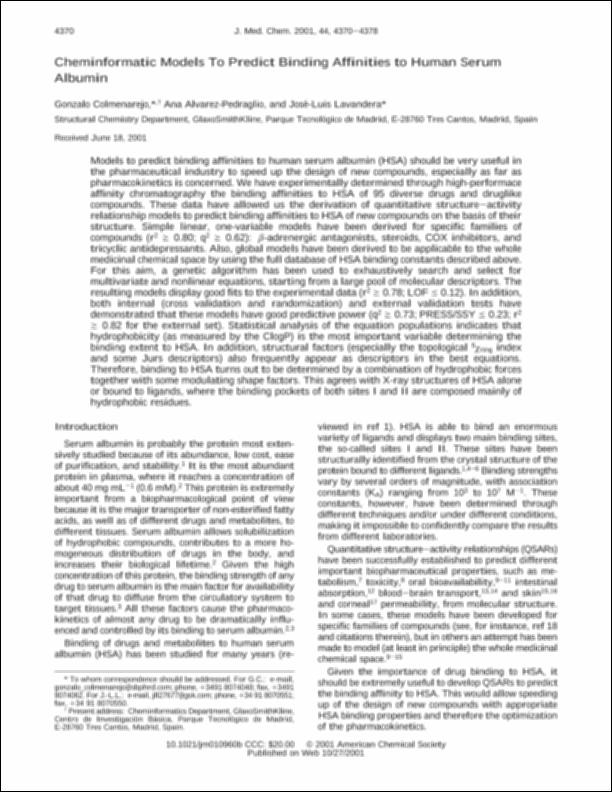Por favor, use este identificador para citar o enlazar este ítem:
http://hdl.handle.net/10637/5539Cheminformatic models to predict binding affinities to human serum albumin.
| Título : | Cheminformatic models to predict binding affinities to human serum albumin. |
| Autor : | Colmenarejo, Gonzalo Lavandera Díaz, José Luis Álvarez Pedraglio, Ana |
| Materias: | Compuestos heterocíclicos. |
| Resumen : | Models to predict binding affinities to human serum albumin (HSA) should be very useful in the pharmaceutical industry to speed up the design of new compounds, especially as far as pharmacokinetics is concerned. We have experimentally determined through high-performace affinity chromatography the binding affinities to HSA of 95 diverse drugs and druglike compounds. These data have allowed us the derivation of quantitative structure-activity relationship models to predict binding affinities to HSA of new compounds on the basis of their structure. Simple linear, one-variable models have been derived for specific families of compounds (r2 g 0.80; q2 g 0.62): â-adrenergic antagonists, steroids, COX inhibitors, and tricyclic antidepressants. Also, global models have been derived to be applicable to the whole medicinal chemical space by using the full database of HSA binding constants described above. For this aim, a genetic algorithm has been used to exhaustively search and select for multivariate and nonlinear equations, starting from a large pool of molecular descriptors. The resulting models display good fits to the experimental data (r2 g 0.78; LOF e 0.12). In addition, both internal (cross validation and randomization) and external validation tests have demonstrated that these models have good predictive power (q2 g 0.73; PRESS/SSY e 0.23; r2 g 0.82 for the external set). Statistical analysis of the equation populations indicates that hydrophobicity (as measured by the ClogP) is the most important variable determining the binding extent to HSA. In addition, structural factors (especially the topological 6øring index and some Jurs descriptors) also frequently appear as descriptors in the best equations. Therefore, binding to HSA turns out to be determined by a combination of hydrophobic forces together with some modulating shape factors. This agrees with X-ray structures of HSA alone or bound to ligands, where the binding pockets of both sites I and II are composed mainly of hydrophobic residues. |
| Descripción : | En: Journal of Medical Chemistry . ISSN 0022-2623. v. 44, 2001, págs 4370-4378 |
| URI : | http://hdl.handle.net/10637/5539 |
| Derechos: | http://creativecommons.org/licenses/by-nc-nd/4.0/deed.es |
| Fecha de publicación : | 1-nov-2001 |
| Centro : | Universidad San Pablo-CEU |
| Aparece en las colecciones: | Medicina |
Los ítems de DSpace están protegidos por copyright, con todos los derechos reservados, a menos que se indique lo contrario.


